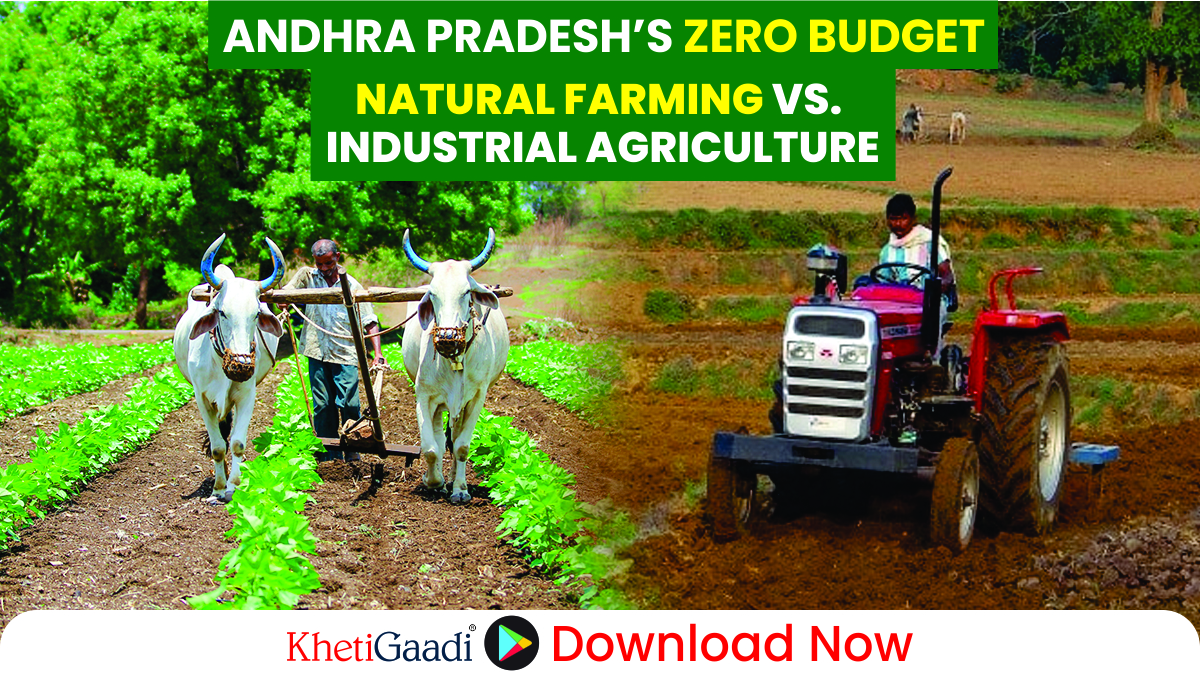Natural Farming vs. Industrial Agriculture: A Vision for 2050
The Andhra Pradesh (AP) model of natural farming, a sustainable and farmer-centric approach, is poised to outperform industrial agriculture by 2050. A collaborative analysis led by the Food and Agriculture Organization (FAO) and the AP state government suggests that natural farming will not only provide more jobs but also boost farmer incomes, improve biodiversity, and ensure food security. A study, titled Re-thinking Food Systems in Andhra Pradesh, India — How Natural Farming Could Feed the Future, was conducted under the broader initiative AgroEco2050. The project engaged scientists, farmers, policymakers, and institutions, envisioning two agricultural scenarios for 2050:
Industrial Agriculture Intensification: Conventional, chemical-based farming systems.
Natural Farming at Scale: Agroecological practices focusing on regeneration and sustainability.
More Jobs, Less Unemployment
By 2050, the analysis predicts that natural farming could employ 10 million farmers, double the number under industrial agriculture (5 million farmers). This is attributed to the lower input costs and premium market value of chemical-free, high-quality produce.
In contrast, industrial agriculture would lead to a 30% unemployment rate, whereas natural farming would reduce this to 7%.
Narrowing the Income Gap
Natural farming could significantly narrow the income disparity between farmers and non-farmers.
- 2024: Farmer incomes were 62% lower than non-farmers.
- 2050 (Natural Farming): This gap would reduce to 22%.
- 2050 (Industrial Agriculture): The gap would remain at 47%.
- Such improvements underline the financial viability of natural farming for rural communities.
Zero Budget Natural Farming: A Game Changer
AP’s Zero Budget Natural Farming (ZBNF) initiative aimed to provide an alternative to chemical-intensive agriculture. It was later renamed Andhra Pradesh Community Managed Natural Farming (APCNF) and targets coverage of six million farmers across six million hectares.
The scheme, implemented through Rythu Sadhikara Samstha, emphasizes the adoption of agroecological practices to reduce input costs and improve soil health.
Environmental and Nutritional Gains
Natural farming offers significant advantages over industrial agriculture in terms of land use, biodiversity, and food quality.
Cultivated Land in 2050:
- Natural Farming: 8.3 million hectares
- Industrial Agriculture: 5.5 million hectares
- Regenerative practices in natural farming can reverse land degradation and desertification.
Food Production:
- Natural Farming: 5,008 kcal/day per capita
- Industrial Agriculture: 4,054 kcal/day per capita
While yields per hectare may be slightly lower, the nutritional content of natural farming produce is superior, being richer in micronutrients and fibre, and free from chemicals and antibiotics.
Participatory Approach to Modelling
The findings are part of a participative exercise where AgroEco2050 brought together a diverse group of stakeholders, including scientists, farmers, government officials, and civil society members, from 2019 to 2023.
This approach ensured the integration of local knowledge and real-world insights into the scenario-building process, enabling stakeholders to co-create sustainable solutions.
Government Schemes Supporting Natural Farming in Andhra Pradesh
- Paramparagat Krishi Vikas Yojana (PKVY) (https://darpg.gov.in):
Promotes organic farming and offers financial support for adopting natural farming practices.
- Rashtriya Krishi Vikas Yojana (RKVY) (https://rkvy.nic.in/):
Provides funds for agricultural infrastructure, skill development, and sustainable farming practices.
- Sub-Mission on Agroforestry (SMAF) (https://nmsa.dac.gov.in):
Encourages integrating trees with agricultural crops to enhance biodiversity and soil health.
- Soil Health Card Scheme (https://soilhealth.dac.gov.in/):
Supports farmers with data on soil quality and recommendations for organic inputs.
Price Trend of Natural Farming Produce Across India
| Region | Average Price of Natural Vegetables(₹/kg) | Industrial Vegetables (₹/kg) |
| North (Punjab) | 30 | 18 |
| East (West Bengal) | 28 | 16 |
| South (Andhra Pradesh) | 32 | 20 |
| West (Maharashtra) | 34 | 22 |
The premium price for natural produce reflects its demand and the willingness of consumers to pay for healthier and eco-friendly options.
Success Stories of Natural Farming in Andhra Pradesh
1. Reviving Soil Health: The Journey of Chiranjeevi Reddy
Location: Anantapur District, Andhra Pradesh
Chiranjeevi Reddy, a farmer with 10 acres of barren land, struggled with declining productivity and rising input costs due to years of chemical farming. In 2017, he transitioned to Zero Budget Natural Farming (ZBNF) under the guidance of Rythu Sadhikara Samstha.
Key Practices Adopted:
Prepared and used organic fertilizers like Jeevamrutha and Panchagavya.
Focused on intercropping with legumes and millets to enhance soil fertility.
Practiced mulching and avoided synthetic chemicals entirely.
Outcome:
His yields improved by 30%, and the cost of farming decreased by nearly 40%.
Soil health showed remarkable improvement, with better water retention and fertility.
He now trains other farmers in the region, advocating natural farming practices.
2. Increased Income with Agroecological Practices: Sita Devi’s Story
Location: Guntur District, Andhra Pradesh
Sita Devi, a marginal farmer, transitioned to natural farming in 2018. Struggling with low profits and crop failure due to excessive use of pesticides, she embraced the APCNF model with support from the local agricultural extension team.
Key Practices Adopted:
Cultivated a mix of vegetables, fruits, and pulses, ensuring year-round income.
Used crop residue and homemade compost as organic manure.
Adopted practices like pheromone traps to control pests.
Outcome:
Her annual income rose from ₹50,000 to ₹1.2 lakh.
Her farm became a model plot, attracting visitors from neighbouring villages.
She has gained recognition as a champion of women-led natural farming in her community.
3. Scaling Success: The Transformation of Srinivasulu Naidu
Location: Chittoor District, Andhra Pradesh
Srinivasulu Naidu, a progressive farmer managing 25 acres, switched to natural farming in 2016 as part of the pilot phase of the ZBNF initiative. Initially sceptical, he saw the benefits within two years of adopting regenerative practices.
Key Practices Adopted:
Practiced crop rotation and planted nitrogen-fixing crops.
Used indigenous seeds and organic pest control solutions.
Incorporated agroforestry by planting fruit trees around his fields.
Outcome:
He reduced input costs by 60% and increased net profits by 50%.
His farm now produces high-demand organic fruits and grains, fetching premium market prices.
Srinivasulu became a mentor, helping 500+ farmers in his district transition to natural farming.
Key Takeaways
Natural farming offers a viable, sustainable alternative to industrial agriculture, benefiting both farmers and the environment.
With proper implementation and government support, it can ensure food security, reduce unemployment, and bridge income disparities by 2050.
Initiatives like AgroEco2050 provide a roadmap for achieving these goals through participative planning and evidence-based policymaking.
Reference links:
Tags:
#NaturalFarming #SustainableAgriculture #AndhraPradesh #Agroecology #FarmerIncome #ZeroBudgetFarming




